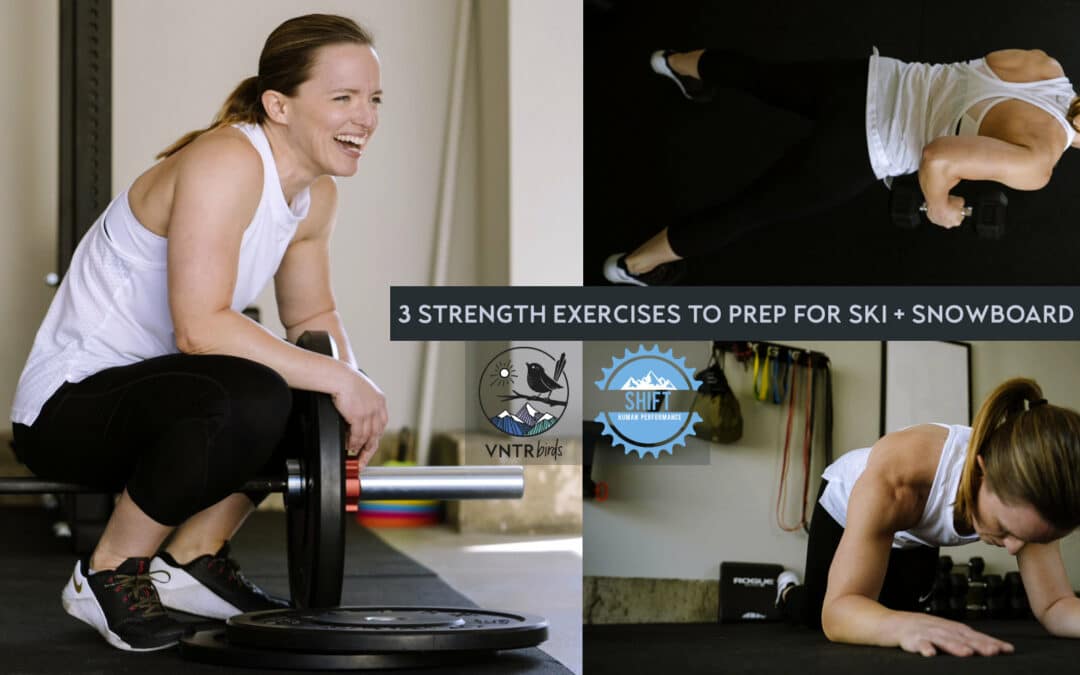The snow is starting to fly in the mountains, which means we are hanging up our bikes and dusting off our winter gear! I’m giving you three incredible exercises to add to your workout routine to help you feel more prepared as you step into your bindings again within the next few weeks. Let’s give them a try!
- Side Planks with Abduction (AKA Star Planks)
Side planks work your core muscles, which are crucial to help you stay balanced and stable on the snow. Adding in the abduction of your leg helps you also develop your glutes and other abductors, which help stabilize your core and legs as you fly down the mountain on your skis or board.
Start by holding a side plank for :10 each side, until you can gradually progress up to :30 each side. Eventually add a leg abduction, focusing on angling your heel up towards the sky to get even more glute engagement. Perform 3 sets.
Progress with a leg abduction, as shown here.
- Lateral Step-Ups
Not only do these work your quad muscles (the muscles in your thighs), but they also strengthen your hamstring and glute muscles, which are powerful and help you stay stable and strong on the mountain. To sweeten it even further, you get a little calf workout as well, which helps offset those hours you spend in stiff boots on the slopes (and in après).
Perform 3 sets of 5-15 step-ups per side; aim to get to a rep count that feels like you can only do 1-2 more reps until you’re exhausted. Once you feel confident doing the bodyweight movement, then add some weight with a dumbbell, kettlebell, or even a backpack. You can make these even more challenging by slowing down your descent back to the starting position – this helps to not only make you more stable, but it helps strengthen your tendons more. Who doesn’t want healthy tendons?
Add weight, as shown here.
- Hamstring Curls on a Medicine Ball (or Sliders)
Now that you’ve mostly worked your core and quads, it’s time to focus on that bootie, with an emphasis on your hamstrings. Your glutes are huge power drivers in any sport, and having strong glutes may also help offset any low back pain, especially if you spend ample time sitting at a desk. Having strong hamstrings helps to keep your knees even more stable and less quad-dominant.
Perform 3 sets of 5-15 reps, performing them slowly for 1-3 seconds in each direction as you progress.
They may also be performed on a larger Swiss ball or floor sliders.
You can easily group these three movements into a “superset” by performing them back-to-back, resting 10 to 30 seconds between each movement. Rest 30 to 90 seconds between each set (or superset). After a few weeks of doing these exercises twice a week, you’ll soon see that you don’t need to do anything extreme to feel stronger and more stable for the winter season.
If you are new to strength training, be smart and go easy at first until you get familiar with the movement. Once you feel more comfortable, then you may increase reps and/or resistance/weight. Always move in a range of motion that is ideal for you regarding any limitations you may have.
Here’s to feeling stronger and more stable on the slopes!
About the author, Jen Kates (Master Health Coach, NASM CPT):
Jen is a PMBIA-certified mountain bike coach for VNTRbirds, and the owner of Shift Human Performance where she’s a full-time coach for folks seeking to feel strong, energetic, confident, and well-fueled in their lives. She’s been coaching for over 15 years and is a self-proclaimed nerd, having spent over 12 years in the research industry in her previous career, so she seeks to balance science with reality for every client. Learn more about her #ShredStrong strength + conditioning program, her health coaching, or listen to her podcast, Making Shift Happen, here: https://shifthumanperformance.com/shredstrong/.

